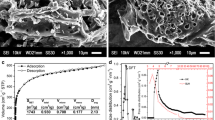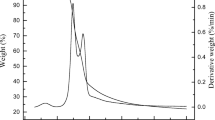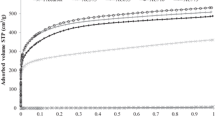Abstract
In this study, thermal and calorimetric techniques are used in order to get a better insight into the progress of the carbonization process of a lignocellulosic material for activated carbon preparation. Therefore, the pyrolysis process of the precursor (olive waste) alone and in the presence of the activating agent (ZnCl2) at different temperatures is followed via thermogravimetry–mass spectroscopy analysis. The mass loss and the temperature programmed desorption profiles of the signals m/e = 16, 18, 28, 30, and 44 allow the determination of the role of the activating agent during the synthesis of the activated carbons at different temperatures. In order to follow the changes in energy during the pyrolysis process, differential scanning calorimetry is used. The obtained results are linked to the properties of the activated carbons obtained at the different temperatures and characterized in a previous paper. In this manner, it is possible not only to determine the thermal events taking place during the pyrolysis process but also to unravel their impact on the textural, structural, and surface properties of the final materials.





Similar content being viewed by others
References
Zhong L, Zhang Y, Ji Y, Norris P, Pan W-P. Synthesis of activated carbon from coal pitch for mercury removal in coal-fired power plants. J Therm Anal Calorim. 2016;123(1):851–60.
Yu F, Li Y, Han S, Ma J. Adsorptive removal of antibiotics from aqueous solution using carbon materials. Chemosphere. 2016;153:365–85.
Lodewyckx P. Adsorption of volatile organic vapours. In: Rufford TE, Zhu J, Hulicova-Jurcakova D, editors. Green carbon materials—advances and applications. Boca Raton: CRC Press; 2014. p. 235–56. ISBN 9789814411134.
Sethia G, Sayari A. Activated carbon with optimum pore size distribution for hydrogen storage. Carbon. 2016;99:289–94.
Melouki R, Llewellyn PL, Tazibet S, Boucheffa Y. Hydrogen adsorption on activated carbons prepared from olive waste: effect of activation conditions on uptakes and adsorption energies. J Porous Mater. 2017;24(1):1–11.
Sebastián D, Alegre C, Calvillo L, Pérez M, Moliner R, Lázaro MJ. Carbon supports for the catalytic dehydrogenation of liquid organic hydrides as hydrogen storage and delivery system. Int J Hydrogen Energy. 2014;39:4109–15.
Lam E, Luong JHT. Carbon materials as catalyst supports and catalysts in the transformation of biomass to fuels and chemicals. ACS Catal. 2014;4(10):3393–410.
Li Q, Zhu Y, Zhao P, Yuan C, Chen M, Wang C. Commercial activated carbon as a novel precursor of the amorphous carbon for high-performance sodium-ion batteries anode. Carbon. 2018;129:85–94.
Piwek J, Platek A, Krzysztof F, Frackowiak E. Carbon-based electrochemical capacitors with acetate aqueous electrolytes. Electrochim Acta. 2016;215:179–86.
Bandosz TJ. Nanoporous carbons: looking beyond their perception as adsorbents, catalyst supports and supercapacitors. Chem Rec. 2016;16:205–2018.
Gomis-Berenguer A, Velasco LF, Velo-Gala I, Ania CO. Photochemistry based on nanoporous carbons: perspectives in energy conversion and environmental remediation. J Colloid Interface Sci. 2017;490:879–901.
Kumar A, Jena HM. High surface area microporous activated carbons prepared from Fox nut (Euryale ferox) shell by zinc chloride activation. Appl Surf Sci. 2015;356:753–61.
Özdemir M, Bolgaz T, Saka C, Sahin Ö. Preparation and characterization of activated carbon from cotton stalks in a two-stage process. J Anal Appl Pyrolysis. 2011;92:171–5.
David E, Kopac J. Activated carbons derived from residual biomass pyrolysis and their CO2 adsorption capacity. J Anal Appl Pyrolysis. 2014;110:322–32.
Correia LB, Fiuza RA Jr, de Andrade RC, Andrade HMC. CO2 capture on activated carbons derived from mango fruit (Mangifera indica L.) seed shells: a TG study. J Therm Anal Calorim. 2018;131(1):579–86.
Gao F, Qu J, Zhao Z, Wang Z, Qiu J. Nitrogen-doped activated carbon derived from prawn shells for high-performance supercapacitors. Electrochim Acta. 2016;190:1134–41.
Marsh H, Rodriguez-Reinoso F. Activated carbon. Amsterdam: Elsevier Science & Technology Books; 2006.
Poletto M, Zattera AJ, Santana RMC. Thermal decomposition of wood: kinetics and degradation mechanisms. Bioresour Technol. 2012;126:7–12.
Yusof N, Ismail AF. Post spinning and pyrolysis processes of polyacrylonitrile (PAN)-based carbon fiber and activated carbon fiber: a review. J Anal Appl Pyrolysis. 2012;93:1–13.
Tazibet S, Velasco LF, Lodewyckx P, Abou M’Hamed D, Boucheffa Y. Study of the carbonization temperature for a chemically activated carbon: influence on the textural and structural characteristics and surface functionalities. J Porous Mater. 2017. https://doi.org/10.1007/s10934-017-0444-8.
Fletcher AJ, Uygur Y, Thomas KM. Role of surface functional groups in the adsorption kinetics of water vapor on microporous activated carbons. J Phys Chem C. 2007;111:8349–59.
Salame II, Bandosz TJ. Study of water adsorption on activated carbons with different degrees of surface oxidation. J Colloid Interface Sci. 1999;210:367–74.
Shen DK, Gu S. The mechanism for thermal decomposition of cellulose and its main products. Bioresour Technol. 2009;100:6496–504.
Nassarl MM, MacKay GDM. Mechanism of thermal decomposition of lignin. Wood Fiber Sci. 1984;16(3):441–53.
Khelfa A, Finqueneisel G, Auber M, Weber JV. Influence of some minerals on the cellulose thermal degradation mechanisms: thermogravimetry and pyrolysis-mass spectrometry studies. J Therm Anal Calorim. 2008;92:795–9.
Wu Q, Pan N, Deng K, Pan D. Thermogravimetry–mass spectrometry on the pyrolysis process of Lyocell fibers with and without catalyst. Carbohyd Polym. 2008;72:222–8.
Scheirs J, Camino G, Tumiatti W. Overview of water evolution during the thermal degradation of cellulose. Eur Polym J. 2001;37:933–42.
Kan T, Strezov V, Evans TJ. Lignocellulosic biomass pyrolysis: a review of product properties and effects of pyrolysis parameters. Renew Sust Energy Rev. 2016;57:1126–40.
Asmadi M, Kawamoto H, Saka S. Gas- and solid/liquid-phase reactions during pyrolysis of softwood and hardwood lignins. J Anal Appl Pyrolysis. 2011;92:417–25.
Shen DK, Gu S. Cellulose chemistry and technology. Cell Chem Technol. 2010;44(1–3):79–87.
Zhou H, Wu C, Meng A, Zhang Y, Williams PT. Effect of interactions of biomass constituents on polycyclic aromatic hydrocarbons (PAH) formation during fast pyrolysis. J Anal Appl Pyrolysis. 2014;110:264–9.
Shen D, Xiao R, Gu S, Zhang H. The overview of thermal decomposition of cellulose in lignocellulosic biomass. In: van de Van T, Kadla J, editors. Cellulose biomass conversion. Rijeka: InTech; 2013.
Wu S, Shen D, Hu J, Zhang H, Xiao R. Intensive interaction region during co-pyrolysis of lignin and cellulose: experimental observation and kinetic assessment. BioResources. 2014;9:2259–73.
Giudicianni P, Cardone G, Ragucci R. Cellulose, hemicellulose and lignin slow steam pyrolysis: thermal decomposition of biomass components mixtures. J Anal Appl Pyrolysis. 2013;100:213–22.
Calvo-Flores FG, Dobado JA, Isac-García J, Martín-Martínez FJ. Chemical characterization and modification of lignins. In: Materials Calvo-Flores FG, Dobado JA, Isac-García J, Martín-Martínez FJ, editors. Lignin and lignans as renewable raw. New York: Wiley; 2015. p. 189–246.
Thommes M, Morlay C, Ahmad R, Joly JP. Assessing surface chemistry and pore structure of active carbons by a combination of physisorption (H2O, Ar, N2, CO2), XPS and TPD-MS. Adsorption. 2011;17:653–61.
Shen W, Li Z, Liu Y. Surface chemical functional groups modification of porous carbon. Recent Patents Chem Eng. 2008;1:27–40.
Tazibet S, Boucheffa Y, Lodewyckx P. Heat treatment effect on the textural, hydrophobic and adsorptive properties of activated carbons obtained from olive waste. Microporous Mesoporous Mater. 2013;170:293–8.
Sun M, Hong L. Impacts of the pendant functional groups of cellulose precursor on the generation of pore structures of activated carbons. Carbon. 2011;49:2173–80.
Author information
Authors and Affiliations
Corresponding author
Rights and permissions
About this article
Cite this article
Tazibet, S., Velasco, L.F., Lodewyckx, P. et al. Systematic study of the role played by ZnCl2 during the carbonization of a chemically activated carbon by TG–MS and DSC. J Therm Anal Calorim 134, 1395–1404 (2018). https://doi.org/10.1007/s10973-018-7246-3
Received:
Accepted:
Published:
Issue Date:
DOI: https://doi.org/10.1007/s10973-018-7246-3




